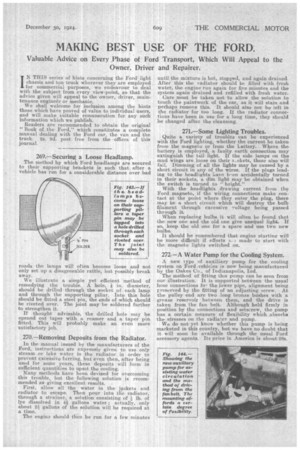MAKING BEST USE OF THE FORD.
Page 21

If you've noticed an error in this article please click here to report it so we can fix it.
Valuable Advice on Every Phase of Ford Transport, Which Will Appeal to the Owner, Driver and Repairer,
/N THIS series of hints concerning the Ford light chassis and ton truck wherever they are employed for commercial purposes, we endeavour to deal with the subject from every view-point, so that the advice given will appeal to the owner, driver, maintenance engineer or mechanic.
We shall welcome for inclusion among the hints those which have proved of value to individual users, and will make suitable remuneration for any such information which we publish. Readers are recommended to obtain the original "Book of the Ford," which constitutes a, complete manual dealing with the Ford car, the van and the truck. 2s. 9d, post free from the offices of this journal.
269.—Securing a Loose Headlamp.
The method by which Ford headlamps are secured to their supporting brackets is such that after a vehicle has run for a considerable distance over bad roads the lamps will often become loose and not only set up a disagreea'ale rattle, but possibly break away.
We illustrate a simple yet efficient method of remedying the trouble. A hole, in. diameter, should be drilled through the socket ofeach lamp and through the supporting pillar. Into this hole should be fitted a steel pin, the ends of which should be riveted over. The joint may be soldered further to strengthen it.
If thought advisable, the drilled hole may be opened out taper with a reamer and a taper pin fitted. This will probably make an even more 'satisfactory job.
270.—Removing Deposits from the Radiator.
In the manual issued by the manufacturers of the Ford, instructions are expressly given to use only stream or lake water in the radiator in order to prevent excessiVe furring, but even then, after being used for some years, these deposits will form in sufficient quantities to upset the cooling. Many methods have been devised for overcoming this trouble, but the following solution is recommended as giving excellent results.
First, allow all the water in the jackets and radiator to escape. Then pour into the radiator, through a strainer, a solution consisting of 1 lb. of lye dissolved in 4 gallon's water • actually, only about 2,1 gallons of the solution will be required at a time.
The engine should. then be run for a few minutes until the mixture is hot, stopped, and again drained. After this the radiator should be filled with fresh water, the engine run again for five minutes and the system again drained and refilled with fresh water.
Care must be taken not to allow the solution to touch the paintwork of the car, as it will stain and perhaps remove this. It should also not be left in the radiator for too long. If the radiator connections have been in use for a long time, they should be changed after the cleansing.
271.—Some Lighting Troubles.
Quite a variety of troubles can be experienced with the Ford lighting, whether the current be taken from the magneto or from the battery. Where the battery is employed, a faulty earth connection may extinguish the tail light. If the side lamps on the mud wings are loose on their r-ekets, these also will fail. Dimming of all the lights may be caused by a short circuit in any of the wires. If the plugs leading to the headlights have la.-.en accidentally turned in their sockets, a dim light may be obtained when the switch is turned to bright." With the headlights drawing current from the Ford magneto, if the wiring connections make con"tact at the point where they enter the plug, there may be a short circuit which will destroy the bulb filament through excessive voltage being passed through it. When replacing bulbs it will often be found that the new one and the old one give unequal light. If so keep the old one for a spare and use two new It should be remembered that engine starting will be more difficult if efforts made to start with the magneto lights switched on.
272.—A Water Pump for the Cooling System.
A new type of auxiliary pump for the cooling system on Ford vehicles is now being manufactured by the Oakes Co., of Indianapolis, Ind. The method of fitting this pump can be seen from our illustration. It is supported between the usual hose connections fothe lower pipe, alignment being reserved by the fitting of an edjusting screw. At the pulley end are two long bronze bushes with a grease reservoir between them, and the drive is taken from the fan belt.. Although held firmly in position by the connections and setscrew, the pump has a certain measure of flexibility which absorbs the stresses on the radiator and pump.
We do not yet know whether this pump is being marketed in this country, but we have no doubt that it will soon be available through the usual Ford accessory agents. Its price in America is about 28s.






























